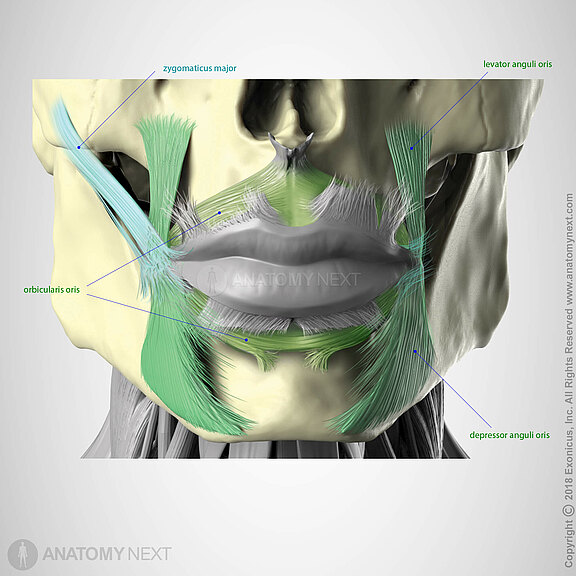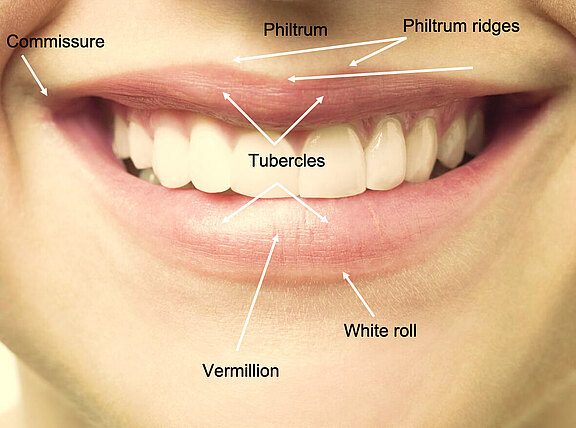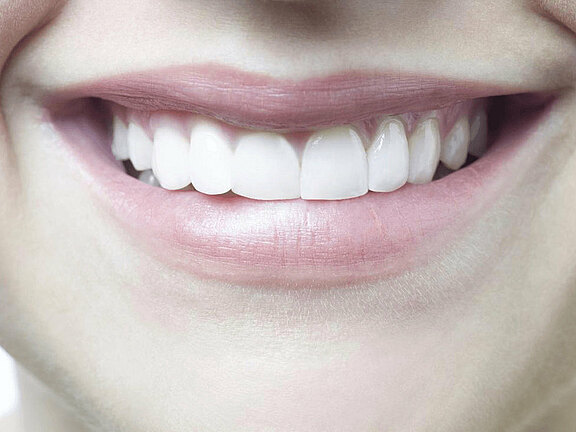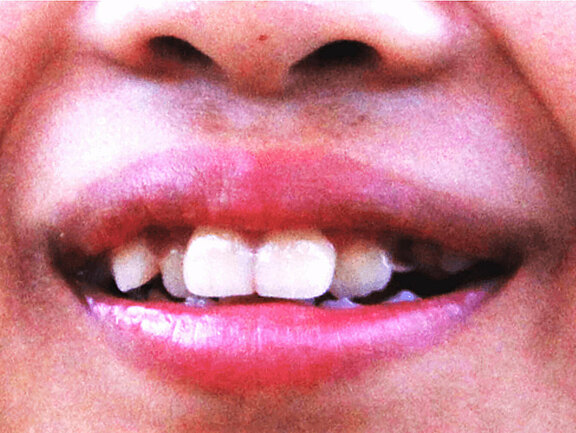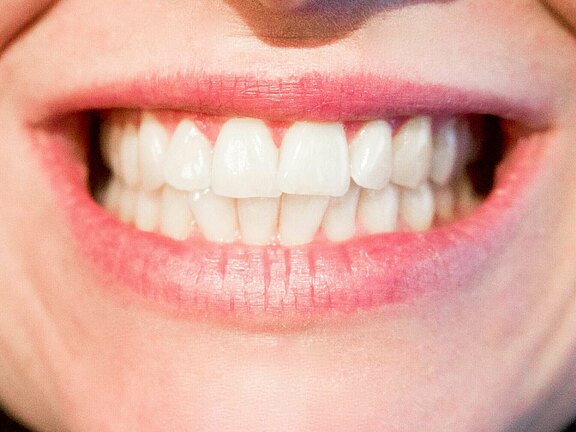This 3D learning model from our friends at ANATOMYNEXT (www.anatomynext.com) shows the dynamic process of a socalled "Mona Lisa smile" (see text below. The function of the zygomatic muscle (M. zygomaticus major) is particularly impressive. It becomes also clear that the smile activates muscles that are far from the mouth as well, such as the M. orbicularis oris. The 3D learning model was created by our friends from ANATOMYNEXT (www.anatomynext.com), who enrich our site with their excellent 2D and 3D teaching models.
The following muscles are sometimes involved in the facial expression of laughter/smiling the large cheekbone muscle, small cheekbone muscle, upper lip lifter, upper lip and nostril lifter for controlling the corner of the mouth with a lateral upward movement and raising of the upper lip. The upper row of teeth becomes visible with increased tension. At the same time, the eye ring muscle tenses and reduces the eyelid fissure slightly when smiling or laughing. With an even "wider smile/laugh", the lower lip is lowered, and the lower row of teeth is exposed by tensioning the mouth angle and lower lip countersinks. In the right half of the face, the influence of the "laughter muscles" described above on the fat bodies in the midface areaare clearly visible. These in turn transfer the force and direction of the muscle pull to the overlying skin.
When smiling with open lips and exposure of the teeth (upper and lower rows of teeth), the different muscle groups around the mouth opening are used "concertedly". Upper lip lifting, lower lip lowering and mouth angle lifting muscle groups work simultaneously, while the mouth ring muscle (orbicularis oris muscle) is largely relaxed. The innervation of the different muscle groups is provided by different nerve branches from different branch groups of the facial nerve. If individual branches and thus muscle groups/muscles malfunction (partial paresis), the lack of controllability leads to asymmetrical distortions of the mouth opening, depending on the failure of the corresponding muscles. The lower lip, for example, stands "high" when the lower lip-lowering muscles (depressor anguli oris muscle, labii inferioris muscle, platysma muscle) have failed.
The human smile is considered a universal expression of happiness, joy and goodwill. It is an innate human behavior that transcends cultural and linguistic boundaries. While its emotional meaning is widely known, science has also explored the multi-layered functions of a smile and described its profound impact on our physical and psychological well-being. In the following, the functions of a smile known to date will be presented from a scientific point of view, giving the reader an understanding of its fascinating role.
Stress reduction
Even a forced smile can reduce stress. When you smile, your brain releases neurotransmitters such as endorphins, which reduce stress hormones such as cortisol. This biological response can help manage stress and anxiety and promote a sense of calm and well-being. Researchers have also found that smiling can lower heart rate and blood pressure, further contributing to stress reduction[01].
Pain relief
The above-mentioned endorphins released by smiling can act as natural painkillers. A genuine smile can therefore reduce the perception of pain and increase pain tolerance[02, 03].
Communication and social bonding
Smiling is also a powerful tool for social interaction. It is a basic form of non-verbal communication that conveys positive emotions such as happiness, friendliness, and approachability. It plays a crucial role in social interactions and helps to build trust and strengthen social bonds[04].
Mood enhancement
The simple act of smiling, even when you're not in a particularly good mood, can also trigger the release of neurotransmitters such as serotonin, which contribute to feelings of happiness and contentment. In this way, smiling can be a self-regulating mechanism to improve your emotional state. In the scientific literature, this is referred to as the "facial feedback hypothesis" (FFH).[05, 06] This means that facial expressions are not just external reflections of internal emotions, but actively help to shape and modulate emotional experiences and thus influence subsequent behavior.
Improved immunity
Smiling has been linked to improved immune system function. The release of endorphins and the reduction of stress hormones can improve the body's ability to fight off disease. Researchers have found that people who smile frequently tend to have stronger immune systems, leading to better health and general well-being.[07, 08]
Increasing attractiveness
Smiling is often associated with attractiveness and influences positive perceptions of beauty and likeability in others. Smiles are perceived as universal signs of positive emotions and friendliness and help to beautify the face.[09-11]
Increasing creativity
Although there is no direct causal link, research suggests that smiling and positive emotions can promote a creative mindset. When individuals are in a positive emotional state, which can be triggered by smiling, they tend to think more broadly and make innovative connections between ideas. This increased cognitive flexibility and openness of thought can lead to increased creativity in problem solving and idea generation [12].
Conclusion
The smile, often seen as a simple facial expression, is actually a powerful and complex phenomenon with far-reaching scientifically studied functions. From reducing stress and relieving pain to boosting mood, promoting social bonding and improving immunity, smiling has a profound effect on our physical and mental wellbeing. As science continues to unravel the mysteries behind this universal gesture, one thing remains clear: smiling is a natural tool for improving our quality of life.
Share your smile with the world and you will not only brighten your own day, but also the days of those around you.
The common classification of human smile patterns was established by the plastic surgeon Leonard Rubin in 1974. He identified three different smile patterns.[13]
Firstly Rubin described the commissural smile, which is evident in two thirds of the world population and also referred to as the Mona Lisa smile.[14] Initially the corners of the mouth are pulled up- and outwards. The following contraction of the M. levator labii superioris shows the upper theet. The lowest point is the incisial edges of the incisors, from where the smile goes convexly up to the molars. The main direction of the movement is directed towards the helix-scalp junction. Jennifer Aniston and Audrey Hepburn can serve as examples for this smile pattern.
Secondly the cuspid smile, that is also known as canine smile, can be found in 31% of world population.[15] The M. levator labii superioris initiates the movement, which is then completed by the contraction of the Mm. zygomatici minor et major.[16] In consequence the lips are visualized like the silhouette of a diamond. The incisial edges of the incisors are at the height of, or even above the molars. Moreover the "gull wing" effect can be detected and classified as the contrary movement pattern to the commissural smile. Inter alii Tiger Woods and Sharon Stone are people, who smile this way.[17]
Thirdly the complexe smile charactertizes two percent of world population, including Will Smith and Julia Roberts.[18] It’s also termed as Hollywood smile or full denture smile. The Mm. zygomatici major et minor, the M. depressor labii inferioris and the M. levator labii superioris contract simultaneously. This causes the upper and lower dental ridge to become visible. In particular the lower lip pulled downward is the feature of this smile pattern.
It should also be stressed that asymmetry can even be beneficial to the human smile. For example, the quality of a smile that does not develop side-by-side within the first 25 to 100ms seems to be superior to a smile that is symmetrical from the very beginning.[19] It should be mentioned that in principle a so-called dynamic symmetry is desirable, i.e. a smile that is very similar but not identical in side comparison.[20] Furthermore, the visibility of the teeth can have both positive and negative effects on the quality of the smile, depending on the angle of the mouth and the extent of the smile.[21] In particular, if the parameters "angle of the mouth" and "extent of the smile" are not very developed, the following applies: The less visible the teeth, the higher the quality of the smile. Exactly the opposite is true if both the corners of the mouth and the smile are strongly developed: The more teeth become visible, the higher the quality of the smile.
Furthermore, it can be stated that the corner of the mouth is generally pulled in the direction of the helix in the course of the smile, forming an average angle of 40 degrees with the horizontal.[22] The direction of the smile shows a symmetry of the left and right halves of the face and is thus in contrast to the extent of the smile. The corner of the mouth is shifted between 7 and 22 mm during the smile process. This shift is asymmetrical with regard to the halves of the face.
With regard to muscle function, smiling can be differentiated into two stages.[23] The first stage is characterized by the contraction of the nasolabial fold. This stage also involves the levator labii superioris muscle, the zygomaticus major muscle and the upper parts of the buccinator muscle. The second stage is defined by the contraction of the periocular (around the eye) muscles. This results in an increased elevation of the upper lip and half-shut eyes.
Sources:
[01] Kraft TL, Pressman SD. Grin and Bear It:The Influence of Manipulated Facial Expression on the Stress Response. Psychological Science. 2012;23(11):1372-8.
[02] Pérez-Aranda A, Hofmann J, Feliu-Soler A, Ramírez-Maestre C, Andrés-Rodríguez L, Ruch W, et al. Laughing away the pain: A narrative review of humour, sense of humour and pain. European Journal of Pain. 2019;23(2):220-33.
[03] Dunbar RIM, Baron R, Frangou A, Pearce E, van Leeuwen EJC, Stow J, et al. Social laughter is correlated with an elevated pain threshold. Proceedings of the Royal Society B: Biological Sciences. 2012;279(1731):1161-7.
[04] Ekman P, Friesen WV. Felt, false, and miserable smiles. Journal of Nonverbal Behavior. 1982;6(4):238-52.
[05] Strack F, Martin LL, Stepper S. Inhibiting and facilitating conditions of the human smile: A nonobtrusive test of the facial feedback hypothesis. Journal of Personality and Social Psychology. 1988;54(5):768-77.
[06] Soussignan R. Duchenne smile, emotional experience, and autonomic reactivity: A test of the facial feedback hypothesis. Emotion. 2002;2(1):52-74.
[07] Cohen S, Alper CM, Doyle WJ, Treanor JJ, Turner RB. Positive Emotional Style Predicts Resistance to Illness After Experimental Exposure to Rhinovirus or Influenza A Virus. Psychosomatic Medicine. 2006;68(6):809-15.
[08] Segerstrom SC, Sephton SE. Optimistic Expectancies and Cell-Mediated Immunity:The Role of Positive Affect. Psychological Science. 2010;21(3):448-55.
[09] Alley TR. Head shape and the perception of cuteness. Developmental Psychology. 1981;17(5):650-4.
[10] Golle J, Mast FW, Lobmaier JS. Something to smile about: The interrelationship between attractiveness and emotional expression. Cognition and Emotion. 2014;28(2):298-310.
[11] Zebrowitz LA, Montepare JM. Social Psychological Face Perception: Why Appearance Matters. Social and Personality Psychology Compass. 2008;2(3):1497-517.
[12] Isen AM, Daubman KA, Nowicki GP. Positive affect facilitates creative problem solving. Journal of Personality and Social Psychology. 1987;52(6):1122-31.
[13] Rubin, L. The Anatomy of a Smile. Plastic and Reconstructive Surgery 1974. p 384-7.
[14] Phillips, E. The Classification of Smile Patterns. J Can Dent Assoc 1999. P. 252-4.
[15] Manjula, W. S. et al. Smile: A review. Journal of pharmacy & bioallied sciences 2015. p. 271-5.
[16] Khan M., Samejo I. et al. Analysis of different characteristics of smile. BDJ Open 6 2020.
[17] Rubin, L. The Anatomy of a Smile. Plastic and Reconstructive Surgery 1974. p 384-7.
[18] Phillips, E. The Classification of Smile Patterns. J Can Dent Assoc 1999. P. 252-4.
[19] Helwig N. E., Sohre N. E., Ruprecht M. R., Guy S. J., Lyford-Pike S. Dynamic properties of successful smiles. PLOS ONE 2017 12(6): e0179708.
[20] Bhuvaneswaran M. Principles of smile design. Journal of Conservative Dentistry 2010. p. 225-32.
[21] Helwig N. E., Sohre N. E., Ruprecht M. R., Guy S. J., Lyford-Pike S. Dynamic properties of successful smiles. PLOS ONE 2017 12(6): e0179708.
[22] Paletz, J. et al. The Shape ofNormal Smile Implications for Facial Paralysis Reconstruction. Plastic and Reconstructive Surgery 1994. P. 790-1.
[23] Peck S, Peck L, Kataja M. The gingival smile line. Angle Orthod 1992; 62(2): 91-100.
